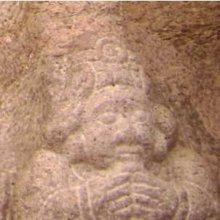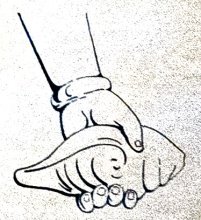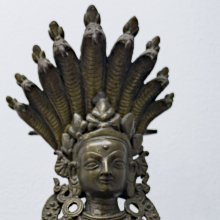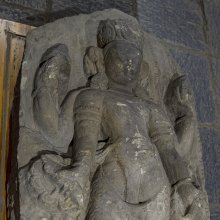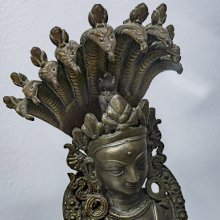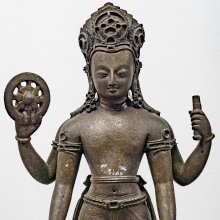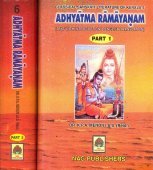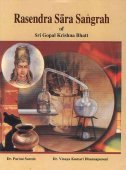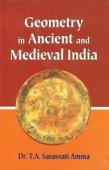Conch: 3 definitions
Introduction:
Conch means something in Hinduism, Sanskrit. If you want to know the exact meaning, history, etymology or English translation of this term then check out the descriptions on this page. Add your comment or reference to a book if you want to contribute to this summary article.
Images (photo gallery)
(+25 more images available)
In Hinduism
Vastushastra (architecture)
Source: Shodhganga: Elements of Art and Architecture in the Trtiyakhanda of the Visnudharmottarapurana (vastu)Conch-shell-shaped Temples (in ancient Indian architecture) are denoted by the Sanskrit term Śaṃkha, as described in literature such as the Viṣṇudharmottarapurāṇa, an ancient Sanskrit text which (being encyclopedic in nature) deals with a variety of cultural topics such as arts, architecture, music, grammar and astronomy.—It is quite difficult to say about a definite number of varieties of Hindu temples but in the Viṣṇudharmottarapurāṇa hundred varieties of temples have been enumerated. For example, Conch-shell-shaped. These temples are classified according to the particular shape, amount of storeys and other common elements, such as the number of pavilions, doors and roofs. [...] The Viṣṇudharmottarapurāṇa relates that the temple named Śaṃkha should be constructed in the shape of a Conch shell.

Vastushastra (वास्तुशास्त्र, vāstuśāstra) refers to the ancient Indian science (shastra) of architecture (vastu), dealing with topics such architecture, sculpture, town-building, fort building and various other constructions. Vastu also deals with the philosophy of the architectural relation with the cosmic universe.
Shilpashastra (iconography)
Source: Shodhganga: Elements of Art and Architecture in the Trtiyakhanda of the Visnudharmottarapurana (shilpa)The Conch is associated with Varuṇa, whose iconography is described in the Viṣṇudharmottarapurāṇa, an ancient Sanskrit text which (being encyclopedic in nature) deals with a variety of cultural topics such as arts, architecture, music, grammar and astronomy.—The Viṣṇudharmottarapurāṇa accepts four hands in the image of Varuṇa where as the Kāśyapaśilpa and the Śilparatna acknowledge only two. The Viṣṇudharmottarapurāṇa says that the image of Varuṇa holds a lotus and a noose with his right hands as well as a conch and a jewel box with his left hands. Thus it is clear that the Viṣṇudharmottarapurāṇa offers a great field of knowledge regarding the nuances of Indian art of Image making [e.g., the conch] during 10th–11th century A.D.

Shilpashastra (शिल्पशास्त्र, śilpaśāstra) represents the ancient Indian science (shastra) of creative arts (shilpa) such as sculpture, iconography and painting. Closely related to Vastushastra (architecture), they often share the same literature.
Mantrashastra (the science of Mantras)
Source: Shodhganga: Kasyapa Samhita—Text on Visha Chikitsa (mantra)The Conch (in Sanskrit: Śaṅkha) refers to one of the five “signs” or “hand-positions” that should accompany the chanting of mantras, according to the Śeṣa-samhitā (p.26, mudrāvidhi).—Mudrā is the position of the hand and finger indicative of various moods and sentiments, and accelerate the effectiveness of the accompanying mantras. The Śeṣasamhitā states that the five Mudrās [e.g., conch (śaṅkha-mudrā)] yield the four puruṣārthas when displayed in the middle and end of a japa. Mantras refers to “that which is chanted by people to obtain their spiritual aspirations”.
Mantrashastra (शिल्पशास्त्र, mantraśāstra) refers to the ancient Indian science of mantras—chants, incantations, spells, magical hymns, etc. Mantra Sastra literature includes many ancient books dealing with the methods reciting mantras, identifying and purifying its defects and the science behind uttering or chanting syllables.
See also (Relevant definitions)
Starts with: Conch-shell, Conchitas.
Full-text (+909): Shankha, Pancajanya, Shankhadhvani, Sindhupushpa, Kambu, Sambuka, Manipushpaka, Devadatta, Shankhaka, Shankhabhrit, Sughosha, Dirghanada, Pavanadhvani, Krimishankha, Trirekha, Varija, Shodashavartta, Bahunada, Anantavijaya, Shankhodaka.
Relevant text
Search found 201 books and stories containing Conch; (plurals include: Conches). You can also click to the full overview containing English textual excerpts. Below are direct links for the most relevant articles:
Jnaneshwari (Bhavartha Dipika) (by Ramchandra Keshav Bhagwat)
Verse 1.14-16 < [Chapter 1 - Arjuna’s Dolour]
Verse 1.17-19 < [Chapter 1 - Arjuna’s Dolour]
Verse 1.13 < [Chapter 1 - Arjuna’s Dolour]
Mahabharata (English) (by Kisari Mohan Ganguli)
Section LI < [Bhagavat-Gita Parva]
Section XXV (Bhagavad Gita Chapter I) < [Bhagavat-Gita Parva]
Section LII < [Sisupala-badha Parva]
Shrimad Bhagavad-gita (by Narayana Gosvami)
Verse 1.16 < [Chapter 1 - Sainya-Darśana (Observing the Armies)]
Verses 1.17-18 < [Chapter 1 - Sainya-Darśana (Observing the Armies)]
Verse 1.19 < [Chapter 1 - Sainya-Darśana (Observing the Armies)]
Ramayana of Valmiki (by Hari Prasad Shastri)
Chapter 7 - The Combat between Vishnu and the Rakshasas < [Book 7 - Uttara-kanda]
Chapter 60 - The Titans rouse Kumbhakarna < [Book 6 - Yuddha-kanda]
Chapter 81 - Vasishtha summons the royal assembly < [Book 2 - Ayodhya-kanda]
The Religion and Philosophy of Tevaram (Thevaram) (by M. A. Dorai Rangaswamy)
Chapter 82 - Thirumaraikkadu or Tirumaraikkatu (Hymn 71) < [Volume 3.7 - Unto the last]
Chapter 96 - Thiruvanchikulam or Tiruvancaikkalam (Hymn 4) < [Volume 3.7 - Unto the last]
Chapter 67 - Thiruvottiyur or Tiruvorriyur (Hymn 54) < [Volume 3.6 - Pilgrim’s progress: away from Otriyur and Cankili]
The Padma Purana (by N.A. Deshpande)
Chapter 75 - The Greatness of Gaṇḍikā < [Section 6 - Uttara-Khaṇḍa (Concluding Section)]
Chapter 29 - The Importance of Gopīcandana < [Section 6 - Uttara-Khaṇḍa (Concluding Section)]
Chapter 68 - The Greatness of Viṣṇu’s Devotees < [Section 6 - Uttara-Khaṇḍa (Concluding Section)]
Related products
